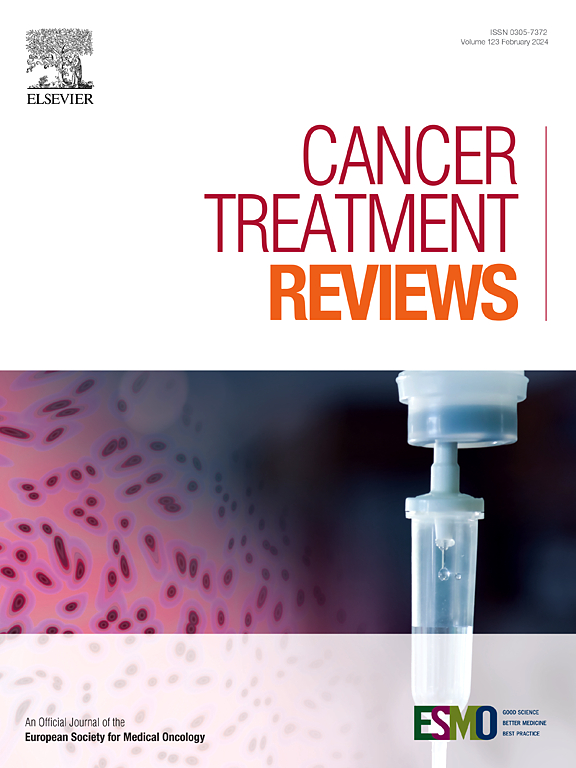A systematic review of phase I trials in patients with ovarian cancer
IF 10.5
1区 医学
Q1 ONCOLOGY
引用次数: 0
Abstract
Background
Ovarian cancer (OC) is the leading cause of death among gynecological malignancies, with limited treatment options for advanced and platinum-resistant disease. This systematic review analyzes phase I trials to assess recent therapeutic advancements.
Methods
We performed a systematic review of phase I trials in OC, published between 2012 and 2023, retrieving data on trial characteristics and outcomes. Studies were classified according to the tested treatment strategies into chemotherapy-only (CO), chemotherapy + non-chemotherapy agents (CNC) and chemotherapy-free (CF).
Results
78 trials were included, with more than 50 % of them published in the last four years. Overall, chemotherapy and immunotherapy were the most investigated agents. Fourteen trials (17.9 %) evaluated a CO strategy, 42 (53.8 %) a CNC combination and 22 (28.2 %) a CF therapy. Dose-limiting toxicities and toxic deaths were observed in 71 % and 100 % of CO studies, in 45.2 % and 21 % of CNC trials and in 37.4 % and 13.6 % of CF trials, respectively. CNC regimens outperformed the other treatment types in terms of efficacy outcomes, including overall response rate (11.5 % CO; 32.2 % CNC; 25.5 % CF), clinical benefit rate (40 % CO; 62 % CNC; 52 % CF) and median progression free survival (mPFS 5.9 months CO; 6.45 months CNC; 4.85 months CF). Trials enrolling platinum resistant or agnostic patients displayed worse clinical outcomes.
Conclusions
In the last years, there has been an increasing number of phase 1 trials assessing new agents and new combinations in patients with OC. Chemotherapy-free strategies display a more favorable safety profile, while regimens combining CNC agents seem to be more effective compared to CO approaches.
卵巢癌患者I期临床试验的系统综述
卵巢癌(OC)是妇科恶性肿瘤中导致死亡的主要原因,晚期和铂耐药疾病的治疗选择有限。本系统综述分析了I期试验,以评估最近的治疗进展。方法:我们对2012年至2023年间发表的OC I期试验进行了系统回顾,检索了试验特征和结果的数据。根据测试的治疗策略将研究分为仅化疗(CO),化疗+非化疗药物(CNC)和无化疗(CF)。结果纳入78项试验,其中50%以上发表于最近4年。总体而言,化疗和免疫治疗是研究最多的药物。14项试验(17.9%)评估了CO策略,42项(53.8%)评估了CNC联合治疗,22项(28.2%)评估了CF治疗。剂量限制性毒性和中毒性死亡分别在71%和100%的CO研究、45.2%和21%的CNC试验以及37.4%和13.6%的CF试验中观察到。在疗效结果方面,CNC方案优于其他治疗类型,包括总有效率(11.5% CO;32.2% cnc;25.5% CF),临床获益率(40% CO;62%数控;52% CF)和中位无进展生存期(mPFS 5.9个月CO;6.45个月CNC;4.85个月CF)。纳入铂耐药或不可知论患者的试验显示出更差的临床结果。在过去的几年中,有越来越多的一期试验评估新的药物和新的联合治疗OC患者。无化疗策略显示出更有利的安全性,而结合CNC药物的方案似乎比CO方法更有效。
本文章由计算机程序翻译,如有差异,请以英文原文为准。
求助全文
约1分钟内获得全文
求助全文
来源期刊

Cancer treatment reviews
医学-肿瘤学
CiteScore
21.40
自引率
0.80%
发文量
109
审稿时长
13 days
期刊介绍:
Cancer Treatment Reviews
Journal Overview:
International journal focused on developments in cancer treatment research
Publishes state-of-the-art, authoritative reviews to keep clinicians and researchers informed
Regular Sections in Each Issue:
Comments on Controversy
Tumor Reviews
Anti-tumor Treatments
New Drugs
Complications of Treatment
General and Supportive Care
Laboratory/Clinic Interface
Submission and Editorial System:
Online submission and editorial system for Cancer Treatment Reviews
 求助内容:
求助内容: 应助结果提醒方式:
应助结果提醒方式:


